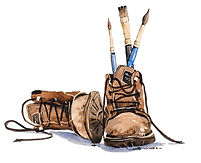OUR LANDSCAPE
walking, painting, blogging - 'taking part in the existence of things'
What exactly is 'landscape'? It is easy to think of it as a countryside view, stretched out in front of us and loved by the painter, walker and photographer. Or just a collection of hills, valleys, streets and woodlands through which we pass or inhabit. It is all of these things, yet infinitely more; a rich tapestry of sounds, sights, smells, and textures, woven on the looms of nature and human enterprise. The rasping call of a pheasant. Soft, curving lines of downland fields and the sharp, jagged sting of a nettle. The organised irregularity of a dry stone wall or the silver uniformity of an urban canal. Think of the landscape not so much as a place to go or see, but more a place in which to be. Expansive vistas to admire, nature's details to experience, and our history to consider.
Unspoilt natural places in Britain are almost impossible to find; the landscapes that we see and experience today have been defined by millennia of human activity; mining, coppicing, grazing, reclaiming, harvesting, travelling, defending, worshipping.

Of course, we must be sensitive to the land and its past, but we must also leave our own marks, with a very light touch. The less frequently we experience the landscapes that we have created and inhabit, trying to preserve them in mothballs, the more heavy-handed we become by implementing erroneous conservation strategies. Listening to the voices that shout the loudest (digitally) is not the right approach. We should be heeding the voice of the farmer, the woodland manager, the gamekeeper, the mountain rescue helper, the tree surgeon and the allotment gardener, comparing such first-hand wisdom with what we can observe and test for ourselves. To do so, we need to be outdoors more often, engaging with the landscape and its people, accumulating knowledge, experience and opinion.
As a watercolour painter my engagement with the landscape is inescapable - my motivation is the landscape, not the painting. I want to be there, seeing the views, experiencing the details and living the moments.

We have benefited greatly from all of these, and the landscape remains the most elegant document we have to record our collective endeavours, our imagination, ambitions, fears, our best work but also our worst. It is the richest record we have of the past. Our feeling of connection to nature, the countryside and urban spaces is no mystery - after all, we have shaped these spaces ourselves for generations.
Today, it seems as though we have retreated somewhat from the landscape. Our approach to it is nervous and tentative, uncertain what to protect and what to change. In our concern not to spoil the countryside we make the mistake, counter-intuitively, of trying to preserve everything, avoiding an inescapable truth - the landscape is not immutable. It changes if we leave it alone, it changes if we manage it. If we ignore or misunderstand the important role that we have played, and should continue to play, in shaping, managing and improving our environment we will stop making landscapes.


Drawing, painting and sketching encourages me to observe and concentrate on my surroundings and allows me to record and share my experiences. Through this blog I hope to share these landscape experiences with you. Come with me through the beautiful ancient woodland, up onto the cliff top, through the heathland heather, and along the city streets. We will scan distant horizons, focus on the structure of a leaf, and maybe appreciate the aesthetic merits of industrial infrastructure. I'll sketch the views. I'll paint the details. Please bear with me as I communicate the joys and frustrations of working in watercolour, and my technical (and not-so technical) considerations in creating landscape art. Most importantly, I hope that I can inspire you to be outdoors yourself. After all, the landscape is Our Landscape. Somewhere for us to learn, observe, touch, smell, taste, imagine, dream, laugh and cry. Alone or together. It is a stadium in which we can walk, run, jump, ride and swim. A playroom, a school and a workplace. Somewhere we can escape to and be still.
The more time we invest in the landscape the greater the reward - the ordinary starts to become extraordinary. As the tide recedes around Britain, do we realise that it reveals a total area that is greater than all the land that has been concreted over? Why is it that the distant hills, covered in green grass and trees, yellow gorse, and warm ochre fields of wheat look the coolest tint of blue? Have you stopped to notice the visible entropy of rust, carving beautiful shapes as it slowly pulls apart the rotting hull of a retired fishing boat on the estuary mudflats? Consider the Small Tortoisehsell butterfly; a transition from the grey, papery prison of a chrysalis into a riot of fiery colour and movement. Inevitably you will find (and hopefully already have) your own ways of engaging with the landscape: walking, photography, conservation work, cycling, pollarding, bird watching, playing cricket, organising donkey rides on Weymouth beach, or just collecting conkers. Do whatever interests and inspires you but let's get back to spending time in the landscape, walking it, watching it, working it, (watercolouring it!), understanding and shaping it. With care, respect and enthusiasm. By being in the landscape we are, as poet John Keats so beautifully put it, 'taking part in the existence of things.'





